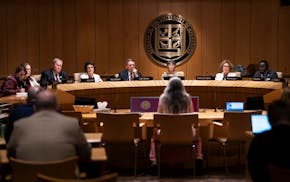A fit of road rage played out last week in downtown Minneapolis when a delivery truck stopped on 3rd Avenue S. during the morning rush hour.
The truck driver switched on his hazard warning lights, got out of the vehicle and walked a short distance up the block while leaving the rig blocking a bike right-turn lane and part of the through traffic lane.
The Drive watched as a frustrated motorist hit the gas pedal and honked the horn as he weaved around the impeding truck and cut another driver off in the lane next to him, coming within an eyelash of sideswiping both vehicles.
In another scene, the Drive watched a motorist turn on flashers and stop in front of an apartment building on Lyndale Avenue, forcing other drivers to veer into oncoming traffic to get around the blocking vehicle. A near-miss happened.
Over the past month, the Drive has received a handful of emails from irritated motorists, mostly just to vent but also to ask if the practice is legal.
Hazard warnings, also called four-way flashers, are for emergency purposes only and to warn other motorists of a temporary hazard, the American Automobile Association said.
According to the Minnesota Driver's Manual, appropriate times to activate flashers include: stopped on the side of a road because of a breakdown or crash; stranded during cold weather; when headlights go out or windshield wipers fail during blinding rain or snow (only until moving off the road to a safe location); if the hood suddenly opens blocking the driver's view; and when driving in a funeral procession.
"Flashers are not meant to be used to pick up or drop off someone, especially while the vehicle is in a lane of traffic," said Lt. Mike Lee with the Minnesota State Patrol.
The driver's manual also states that it is illegal to stop or park on a freeway except in an emergency. Running out of fuel is not considered an emergency, the book says.
Many motorists activate hazards when driving slow in bad weather, but that is illegal is nearly a dozen states and generally not recommended.
"Using your hazard lights can distract or confuse others on the road" who may not know which lane a motorist is in or if another driver is changing lanes, the AAA said. "If you feel conditions warrant the need for hazard lights, consider stopping and waiting out the weather."
On Minneapolis streets, vehicles that are double parked or obstructing traffic are subject to a citation regardless if hazard lights are on, a city spokesman wrote in an email. Traffic control responds to complaints phoned into 311 in real time and through proactive enforcement, the spokesman added.
The issue is on the city's radar.
"Short-term vehicle access needs like deliveries, rideshare and loading are something the city is actively working to better understand and address," the spokesman said. "We're currently studying our various access needs and will incorporate those findings into our overall curb access plans to support new street designs."
Distracted driving
The tally is in and more than 6,450 motorists were cited in Minnesota during April's Distracted Driving Awareness month enforcement campaign. That was 1,000 more than last year.
"We are not out to write tickets, we're out to save lives," said Mike Hanson, director of the Minnesota Department of Public Safety's Office of Traffic Safety. "But if drivers won't take safety seriously, enforcement becomes necessary. Every time you take your eyes off the road, you're gambling with your life and the lives of others around you. Just put the phone down."
Things to know about the retrial of Karen Read in the killing of her police officer boyfriend

Foundation submitted voter registration applications with fake IDs, charges say

University of Minnesota faculty and students urge Regents to reject budget cuts and tuition hikes

Teenage boy arrested in connection with fatal shooting outside Northtown Mall

